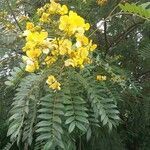Shrub or small tree 2-6 m high, sometimes described as scandent. Branchlets brown, puberulous to pubescent, longitudinally ridged when young. Leaves paripinnate; stipules 10-15 mm long, leafy, cordate-auriculate to reniform, often caudate-attenuate, pubescent, subpersistent; petiole 1.5-4.5 cm long, pubescent; rachis up to 20 cm long, appressed-pubescent, with scattered elongate reddish glands among the hairs, with a stalked botuliform often caducous reddish gland 1.5-2 mm long between each of the proximal 1-4 leaflet pairs; leaflets in 6-10 pairs, 4-7 x 1.5-3.5 cm, the middle ones usually the largest, ovate to ovate-elliptic, base cuneate to rounded or cordate, often slightly asymmetrical, apex acute to acuminate, mucronate, sparsely hairy above, more densely so beneath, with appressed hairs and reddish elongated glands; petiolules up to 1 mm long, appressed-pubescent. Inflorescences paniculate, terminal, made up of corymbose racemes; primary inflorescence branches (racemes) up to 9 cm long, subtended by reduced caducous leaves with few pinnae; stipules of these similar to those of foliage leaves, relatively persistent; proximal bracts of racemes very broadly ovate, acuminate, distal ones narrower, all usually densely pubescent, subpersistent; proximal pedicels up to 5 cm long at anthesis; distal ones shorter. Sepals 5, dimorphic, three c. 12 x 10 mm, two c. 7 x 5 mm, broadly ovate-elliptic, pubescent. Petals golden yellow, unequal, clawed, the largest up to 22 x 11 mm, oblong, somewhat asymmetrical, rounded at apex, the others broadly elliptic to ovate, rounded or retuse. Stamens 10, three large with arcuate fertile anthers 7-10 mm long and filaments 8-12 mm long, four fertile with slightly curved anthers 6-8 mm long and straight filaments c. 1 mm long, and three small, probably sterile, with reniform to subspherical anthers and straight filaments 2-4 mm long. Ovary 10-12 mm long, straight or curved, terete, densely appressed-pubescent with white hairs and reddish glands; style 4.5-5.5 mm long, terete, glabrous; stigma terminal, recessed, surrounded by a fringe of hairs. Pod black with brown margins, linear, 13-24 x 0.8-1.2 cm, straight or irregularly curved, chambered, glabrous or appressed-pubescent, indehiscent. Seeds brown, in a single row, 5-6 x 4 mm, obovate, flattened, with two narrowly elliptic areoles on the narrow faces.
A shrub or small tree that loses its leaves during the year. It grows 7 m high. It is slightly hairy. The stems are slender and grey. The leaves are up to 15-26 cm long. These have leafy structures (stipules) at their base. They have 6-11 pairs of leaflets. The leaflets have short stalks and taper to the tip. They are 4 cm long by 1.5 cm wide. They are dark green and glossy but can be slightly hairy underneath. There is a gland between each pair of leaflets. The flowers are in groups 15 cm long in the axils of leaves. They are also in large branching groups at the ends of branches. They are yellow and have a scent. The fruit are pods 20 cm long and 1.2 cm wide. They hang down. They are dark coloured and have a thickened edge and are slightly curved. They have many seeds. The seeds are edible.
Leaves paripinnate; stipules 10–15 mm long, leafy, cordate-auriculate to reniform, often caudate-attenuate, pubescent, subpersistent; petiole 1.5–4.5 cm long,>i> pubescent;>i> rachis up to 20 cm long,>i> appressed pubescent, with scattered elongate reddish glands among the hairs, with a stalked botuliform often caducous reddish gland 1.5–2 mm long between each of the proximal 1–4 leaflet pairs; leaflets in 6–10 pairs, 4–7 × 1.5–3.5 cm, the middle ones usually the largest,>i> ovate to ovate-elliptic, base cuneate to rounded or cordate, often slightly asymmetrical, apex acute to acuminate, mucronate,>i> sparsely hairy above, more densely so beneath, with appressed hairs and reddish elongated glands;>i> petiolules up to 1 mm long, appressed-pubescent.
Inflorescences paniculate, terminal, made up of corymbose racemes; primary inflorescence branches (racemes) up to 9 cm long, subtended by reduced caducous leaves with few pinnae; stipules of these similar to those of foliage leaves, relatively persistent; proximal bracts of racemes very broadly ovate, acuminate, distal ones narrower, all usually densely pubescent, subpersistent; proximal pedicels up to 5 cm long at anthesis; distal ones shorter.>i> Sepals 5, dimorphic, three c.12 × 10 mm, two c.7 × 5 mm,>i> broadly ovate-elliptic,>i> pubescent.
Stamens 10, three large with arcuate fertile anthers 7–10 mm long and filaments 8–12 mm long, four fertile with slightly curved anthers 6–8 mm long and straight filaments c.1 mm long, and three small, probably sterile, with reniform to subspherical anthers and straight filaments 2–4 mm long.
Ovary 10–12 mm long, straight or curved, terete,>i> densely appressed-pubescent with white hairs and reddish glands; style 4.5–5.5 mm long,>i> terete, glabrous; stigma terminal, recessed, surrounded by a fringe of hairs.
Shrub or small tree, up to 7 m high. Stipules persis-tent, conspicuous, leafy, semicordate to reniform, with one end attenuate-caudate. Pods 100-250 x 10-15 mm, dark brown to black. Flowers deep yellow and brown-veined.
Petals golden yellow, unequal, clawed, the largest up to 22 × 11 mm, oblong, somewhat asymmetrical, rounded at apex, the others broadly elliptic to ovate, rounded or retuse.
Pod black with brown margins, linear, 13–24 × 0.8–1.2 cm, straight or irregularly curved, chambered, glabrous or appressed-pubescent, indehiscent.
Seeds brown, in a single row,>i> 5–6 × 4 mm, obovate, flattened, with two narrowly elliptic areoles on the narrow faces.
Branchlets brown, puberulous to pubescent, longitudinally ridged when young.
Shrub or small tree 2–6 m high, sometimes described as scandent.


